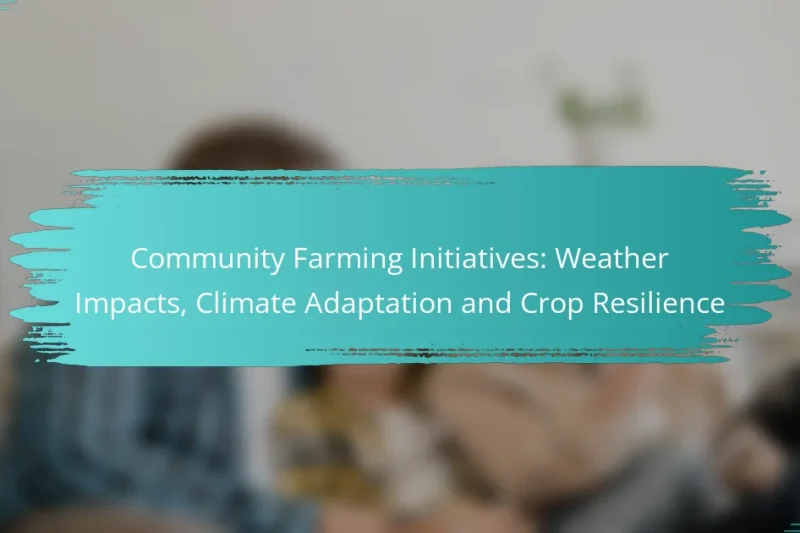Community farming initiatives in urban areas play a crucial role in enhancing food security and promoting … Community Farming Initiatives: Urban Challenges, Funding Issues and Land ConflictsRead more
Challenges in Community Farming Initiatives
Community farming initiatives are vital for promoting local food systems and enhancing community engagement, yet they often encounter significant challenges. Issues such as resource allocation, regulatory hurdles, and market access can impede their effectiveness. By addressing these obstacles and leveraging support from local governments and diverse funding sources, communities can cultivate sustainable farming practices that benefit everyone involved.
Community Farming Initiatives: Land Use Conflicts, Zoning Regulations and Community Engagement
Community farming initiatives represent a vital collaboration among local residents to cultivate land for agricultural purposes, … Community Farming Initiatives: Land Use Conflicts, Zoning Regulations and Community EngagementRead more
Community Farming Initiatives: Conflict Management, Participant Engagement and Communication Strategies
Community farming initiatives thrive on effective conflict management, participant engagement, and robust communication strategies. By emphasizing … Community Farming Initiatives: Conflict Management, Participant Engagement and Communication StrategiesRead more
Community Farming Initiatives: Regulatory Compliance, Permitting Processes and Legal Considerations
Community farming initiatives represent a vital movement where individuals unite to cultivate land for sustainable food … Community Farming Initiatives: Regulatory Compliance, Permitting Processes and Legal ConsiderationsRead more
Community Farming Initiatives: Competition Factors, Market Strategies and Sustainability Practices
Community farming initiatives play a crucial role in enhancing local food production and promoting sustainability in … Community Farming Initiatives: Competition Factors, Market Strategies and Sustainability PracticesRead more
Community Farming Initiatives: Funding Strategies, Resource Allocation and Financial Planning
Community farming initiatives play a vital role in promoting sustainable agriculture and enhancing local food systems. … Community Farming Initiatives: Funding Strategies, Resource Allocation and Financial PlanningRead more
Community Farming Initiatives: Weather Impacts, Climate Adaptation and Crop Resilience
Community farming initiatives are increasingly challenged by weather impacts that disrupt crop yields and sustainability. As … Community Farming Initiatives: Weather Impacts, Climate Adaptation and Crop ResilienceRead more
What are the common challenges in community farming initiatives?
Community farming initiatives often face several challenges that can hinder their success, including resource allocation, community engagement, regulatory hurdles, market access, and environmental sustainability. Addressing these issues is crucial for fostering effective and sustainable farming practices within communities.
Resource allocation
Effective resource allocation is vital for community farming initiatives, as it determines how funds, land, and materials are distributed among participants. Limited financial resources can lead to inadequate infrastructure and insufficient tools for farming, which can stifle productivity.
To optimize resource allocation, communities should prioritize transparent budgeting and seek partnerships with local businesses or government programs that can provide grants or donations. Regular assessments of resource needs can help ensure that all members have access to what they require for successful farming.
Community engagement
Community engagement is essential for the sustainability of farming initiatives, as it fosters a sense of ownership and commitment among participants. Low participation rates can result from a lack of awareness or interest in the project’s goals.
To enhance engagement, organizers should hold regular meetings, workshops, and social events that encourage collaboration and communication. Utilizing social media platforms can also help keep community members informed and motivated to participate actively in farming activities.
Regulatory hurdles
Regulatory hurdles can pose significant challenges for community farming initiatives, as local laws and zoning regulations may restrict farming activities. Navigating these regulations can be complex and time-consuming, often requiring permits or compliance with specific standards.
Communities should familiarize themselves with local agricultural regulations and consider forming coalitions to advocate for more supportive policies. Engaging with local government officials can also facilitate a better understanding of the regulatory landscape and help identify potential exemptions or assistance programs.
Market access
Accessing markets is a critical challenge for community farming initiatives, as it affects the ability to sell produce and generate income. Limited connections to local markets can hinder profitability and sustainability.
To improve market access, community farms can explore partnerships with local restaurants, farmers’ markets, and grocery stores. Establishing a cooperative model can also enhance bargaining power and streamline distribution channels, making it easier to reach consumers.
Environmental sustainability
Environmental sustainability is a pressing concern for community farming initiatives, as practices that harm the ecosystem can undermine long-term viability. Issues such as soil degradation, water usage, and biodiversity loss must be carefully managed.
Implementing sustainable farming practices, such as crop rotation, organic farming, and integrated pest management, can help mitigate environmental impacts. Communities should also consider educational programs to raise awareness about sustainable practices among participants and promote eco-friendly farming methods.
How can community farming initiatives overcome funding challenges?
Community farming initiatives can overcome funding challenges by exploring diverse funding sources, including government grants, partnerships with non-governmental organizations (NGOs), and crowdfunding campaigns. Each of these options provides unique benefits and considerations that can help sustain and grow community farming projects.
Grants from local governments
Local governments often provide grants to support community farming initiatives as part of their efforts to promote sustainability and local food systems. These grants can vary widely in amount, typically ranging from a few hundred to several thousand dollars, depending on the project’s scope and the specific funding program.
To access these grants, community farms should research available programs and carefully follow application guidelines. It’s essential to demonstrate how the initiative aligns with local agricultural goals and community needs. Regularly checking government websites or attending local agricultural meetings can help identify new funding opportunities.
Partnerships with NGOs
Forming partnerships with NGOs can provide community farming initiatives with not only funding but also valuable resources and expertise. Many NGOs focus on food security, environmental sustainability, or community development, making them potential allies in securing financial support.
When approaching NGOs, it’s beneficial to present a clear vision of the farming initiative and how it aligns with the NGO’s mission. Collaborating on projects can lead to shared funding applications, thereby increasing the chances of success. Additionally, NGOs may offer training or volunteer support, further enhancing the initiative’s capacity.
Crowdfunding campaigns
Crowdfunding campaigns allow community farming initiatives to raise funds directly from the public, leveraging social media and online platforms. This method can be particularly effective for smaller projects or specific needs, such as purchasing equipment or funding educational programs.
To launch a successful crowdfunding campaign, it’s crucial to create a compelling narrative that resonates with potential backers. Clear goals, engaging visuals, and regular updates can help maintain interest and encourage contributions. Platforms like Kickstarter or GoFundMe can be used, but it’s important to factor in any fees associated with these services when setting funding targets.
What role do local governments play in supporting community farming?
Local governments play a crucial role in supporting community farming by creating policies, providing infrastructure, and offering financial incentives. Their involvement can significantly enhance the sustainability and success of these initiatives, fostering local food systems and community engagement.
Policy development
Local governments are responsible for developing policies that promote community farming. This includes zoning regulations that allow for urban agriculture, as well as guidelines that support land use for farming initiatives. Effective policies can encourage community participation and ensure that farming practices align with local needs.
For example, cities like Portland have implemented policies that facilitate the establishment of community gardens and urban farms, making it easier for residents to engage in agricultural activities. Local governments should regularly review and update these policies to adapt to changing community dynamics and agricultural practices.
Infrastructure support
Infrastructure support from local governments is essential for the success of community farming initiatives. This can include providing access to water, land, and transportation networks that facilitate the distribution of produce. Well-maintained infrastructure can help reduce operational challenges for community farms.
In some areas, local governments have invested in shared facilities, such as community greenhouses or farmers’ markets, which can serve as hubs for local agricultural activities. Ensuring that these infrastructures are accessible and functional is key to fostering a thriving community farming environment.
Financial incentives
Financial incentives from local governments can significantly boost community farming efforts. These incentives may include grants, subsidies, or tax breaks aimed at reducing the financial burden on community farmers. Such support can encourage more individuals to participate in farming initiatives.
For instance, some municipalities offer funding programs that help cover the costs of equipment or seeds for community farms. Local governments should consider creating clear application processes and eligibility criteria to ensure that these financial incentives effectively reach those who need them most.
How can technology improve community farming initiatives?
Technology can significantly enhance community farming initiatives by streamlining operations, improving data management, and facilitating market access. By leveraging digital tools, farmers can optimize their resources, increase productivity, and connect with consumers more effectively.
Data management tools
Data management tools help community farmers track crop yields, monitor soil health, and manage resources efficiently. These tools can include software for record-keeping, analysis, and reporting, allowing farmers to make informed decisions based on real-time data. For instance, using cloud-based platforms can enable farmers to share information and collaborate on best practices.
When selecting data management tools, consider user-friendliness and integration capabilities with existing systems. Look for solutions that offer mobile access, as this can enhance usability in the field. Popular options include FarmLogs and Cropio, which provide comprehensive features tailored to agricultural needs.
Online marketplaces
Online marketplaces provide community farmers with direct access to consumers, reducing reliance on intermediaries and increasing profit margins. Platforms like LocalHarvest and Farmigo enable farmers to list their products, set prices, and manage orders, creating a more transparent supply chain. This direct-to-consumer model can lead to better pricing and increased customer loyalty.
To maximize the benefits of online marketplaces, farmers should focus on high-quality product images and detailed descriptions. Engaging with customers through social media can also enhance visibility and drive sales. It’s essential to understand the fees associated with these platforms, as they can vary significantly.
Mobile apps for coordination
Mobile apps facilitate coordination among community farmers, helping them manage tasks, share resources, and communicate effectively. Apps like Trello or Slack can be utilized for project management and team collaboration, ensuring everyone is aligned on goals and responsibilities. This can be particularly useful for larger community farming projects that require teamwork.
When implementing mobile apps, ensure that all participants are comfortable using the technology. Providing training sessions can help ease the transition and improve overall engagement. Additionally, consider apps that offer offline capabilities, as internet access may be limited in rural areas.
What are the best practices for community engagement in farming initiatives?
Effective community engagement in farming initiatives involves fostering strong relationships among participants and ensuring open communication. Best practices include regular meetings, collaborative decision-making, and inclusive activities that encourage participation from all community members.
Regular community meetings
Regular community meetings are essential for maintaining engagement in farming initiatives. These gatherings provide a platform for sharing updates, discussing challenges, and brainstorming solutions collectively. Aim for monthly meetings to keep everyone informed and involved.
During these meetings, establish a clear agenda and encourage participation from all members. This can include updates on farming progress, financial discussions, and planning for upcoming events. Consider rotating the meeting location to make it accessible for all community members.
To enhance the effectiveness of these meetings, use tools like surveys or feedback forms to gather input on topics of interest. This ensures that discussions are relevant and that all voices are heard, fostering a sense of ownership and commitment to the initiative.






